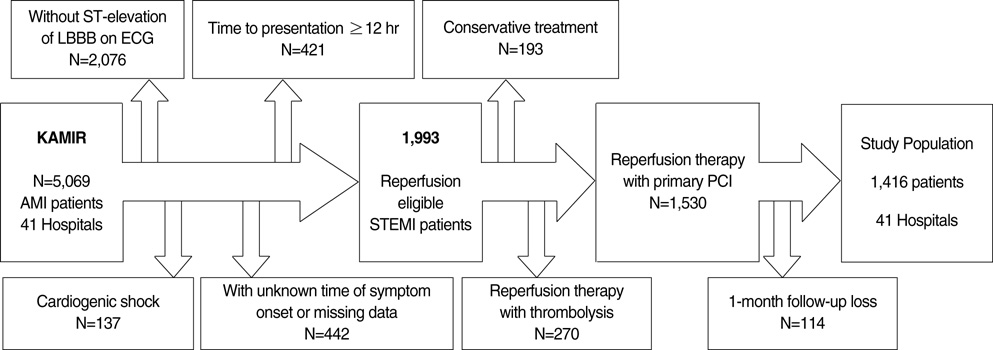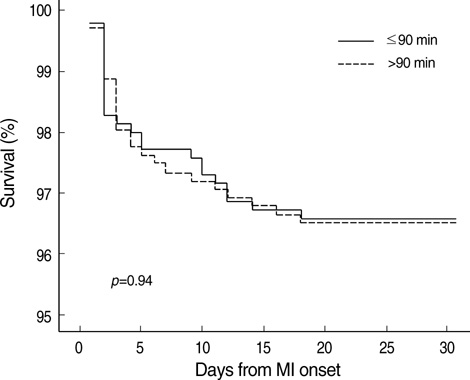The Impact of Initial Treatment Delay Using Primary Angioplasty on Mortality among Patients with Acute Myocardial Infarction: from the Korea Acute Myocardial Infarction Registry
- Affiliations
-
- 1Department of Medicine, Samsung Medical Center, Sungkyunkwan University School of Medicine, Seoul, Korea. hcgwon@smc.samsung.co.kr
- 2Heart Center of Chonnam National University Hospital, Chonnam National University Research Institute of Medical Sciences, Gwangju, Korea.
- KMID: 1786869
- DOI: http://doi.org/10.3346/jkms.2008.23.3.357
Abstract
- The impact of treatment delays to reperfusion on patient mortality after primary percutaneous coronary intervention (PCI) for ST elevation myocardial infarction (STEMI) is controversial. We analyzed 5,069 patients included in the Korea Acute Myocardial Infarction Registry (KAMIR) between November 2005 and January 2007. We selected 1,416 patients who presented within 12 hr of symptom onset and who were treated with primary PCI. The overall mortality at one month was 4.4%. The medians of door-to-balloon time, symptom onset-to-balloon time, and symptom onset-to-door time were 90 (interquartile range, 65-136), 274 (185-442), and 163 min (90-285), respectively. One-month mortality was not increased significantly with any increasing delay in door-to-balloon time (4.3% for < or =90 min, 4.4% for >90 min; p=0.94), symptom onset-to-balloon time (3.9% for < or =240 min, 4.8% for >240 min; p=0.41), and symptom onset-to-door time (3.3% for < or =120 min, 5.0% for >120 min; p=0.13). These time variables had no impact on one-month mortality in any subgroup. Thus, this first nationwide registry data in Korea showed a good result of primary PCI, and the patient prognosis may not depend on the initial treatment delay using the current protocols.
Keyword
MeSH Terms
Figure
Cited by 5 articles
-
Clinical Effects of Hypertension on the Mortality of Patients with Acute Myocardial Infarction
Dong Goo Kang, Myung Ho Jeong, Yongkeun Ahn, Shung Chull Chae, Seung Ho Hur, Taek Jong Hong, Young Jo Kim, In Whan Seong, Jei Keon Chae, Jay Young Rhew, In Ho Chae, Myeong Chan Cho, Jang Ho Bae, Seung Woon Rha, Chong Jin Kim, Yang Soo Jang, Junghan Yoon, Ki Bae Seung, Seung Jung Park,
J Korean Med Sci. 2009;24(5):800-806. doi: 10.3346/jkms.2009.24.5.800.Clinical Benefit of Low Molecular Weight Heparin for ST-segment Elevation Myocardial Infarction Patients Undergoing Primary Percutaneous Coronary Intervention with Glycoprotein IIb/IIIa Inhibitor
Jung Sun Cho, Sung-Ho Her, Ju Yeal Baek, Mahn-Won Park, Hyoung Doo Kim, Myung Ho Jeong, Young keun Ahn, Shung Chull Chae, Seung Ho Hur, Taek Jong Hong, Young Jo Kim, In Whan Seong, Jei Keon Chae, Jay Young Rhew, In Ho Chae, Myeong Chan Cho, Jang Ho Bae, Seung Woon Rha, Chong Jim Kim, Donghoon Choi, Yang Soo Jang, Junghan Yoon, Wook Sung Chung, Jeong Gwan Cho, Ki Bae Seung, Seung Jung Park,
J Korean Med Sci. 2010;25(11):1601-1608. doi: 10.3346/jkms.2010.25.11.1601.Performance of Reperfusion Therapy and Hospital Mortality in ST-Elevation Myocardial Infarction Patients with Non-Chest Pain Complaints
Jae Phil Na, Kyu Chul Shin, Seunghwan Kim, Yoo Seok Park, Sung Phil Chung, In Cheol Park, Joon Min Park, Min Joung Kim
Yonsei Med J. 2014;55(3):617-624. doi: 10.3349/ymj.2014.55.3.617.Reperfusion Strategies in Acute ST-segment Elevation Myocardial Infarction
Young-Jo Kim
J Korean Med Assoc. 2010;53(3):196-203. doi: 10.5124/jkma.2010.53.3.196.Gender Differences in Delay Seeking Treatment and Related Experiences in Patients with Acute Myocardial Infarction
Mi-Suk Won, Nah-Mee Shin, Eunsook Kim
Korean J Adult Nurs. 2016;28(4):459-469. doi: 10.7475/kjan.2016.28.4.459.
Reference
-
1. Fibrinolytic Therapy Trialists' (FTT) Collaborative Group. Indications for fibrinolytic therapy in suspected acute myocardial infarction: collaborative overview of early mortality and major morbidity results from all randomised trials of more than 1000 patients. Lancet. 1994. 343:311–322.2. Newby LK, Rutsch WR, Califf RM, Simoons ML, Aylward PE, Armstrong PW, Woodlief LH, Lee KL, Topol EJ, Van de Werf F. Time from symptom onset to treatment and outcomes after thrombolytic therapy. GUSTO-1 Investigators. J Am Coll Cardiol. 1996. 27:1646–1655.3. Goldberg RJ, Mooradd M, Gurwitz JH, Rogers WJ, French WJ, Barron HV, Gore JM. Impact of time to treatment with tissue plasminogen activator on morbidity and mortality following acute myocardial infarction (The second National Registry of Myocardial Infarction). Am J Cardiol. 1998. 82:259–264.
Article4. Zijlstra F, Patel A, Jones M, Grines CL, Ellis S, Garcia E, Grinfeld L, Gibbons RJ, Ribeiro EE, Ribichini F, Granger C, Akhras F, Weaver WD, Simes RJ. Clinical characteristics and outcome of patients with early (<2 h), intermediate (2-4 h) and late (>4 h) presentation treated by primary coronary angioplasty or thrombolytic therapy for acute myocardial infarction. Eur Heart J. 2002. 23:550–557.5. Antman EM, Anbe DT, Armstrong PW, Bates ER, Green LA, Hand M, Hochman JS, Krumholz HM, Kushner FG, Lamas GA, Mullany CJ, Ornato JP, Pearle DL, Sloan MA, Smith SC Jr, Alpert JS, Anderson JL, Faxon DP, Fuster V, Gibbons RJ, Gregoratos G, Halperin JL, Hiratzka LF, Hunt SA, Jacobs AK. ACC/AHA guidelines for the management of patients with ST-elevation myocardial infarction: a report of the American College of Cardiology/American Heart Association Task Force on Practice Guidelines (Committee to Revise the 1999 Guidelines for the Management of Patients with Acute Myocardial Infarction). Circulation. 2004. 110:e82–e292.6. Brodie BR, Stuckey TD, Wall TC, Kissling G, Hansen CJ, Muncy DB, Weintraub RA, Kelly TA. Importance of time to reperfusion for 30-day and late survival and recovery of left ventricular function after primary angioplasty for acute myocardial infarction. J Am Coll Cardiol. 1998. 32:1312–1319.
Article7. Antoniucci D, Valenti R, Migliorini A, Moschi G, Trapani M, Buonamici P, Cerisano G, Bolognese L, Santoro GM. Relation of time to treatment and mortality in patients with acute myocardial infarction undergoing primary coronary angioplasty. Am J Cardiol. 2002. 89:1248–1252.
Article8. De Luca G, Suryapranata H, Zijlstra F, van't Hof AW, Hoorntje JC, Gosselink AT, Dambrink JH, de Boer MJ. Symptom-onset-to-balloon time and mortality in patients with acute myocardial infarction treated by primary angioplasty. J Am Coll Cardiol. 2003. 42:991–997.
Article9. Brodie BR, Stone GW, Cox DA, Stuckey TD, Turco M, Tcheng JE, Berger P, Mehran R, McLaughlin M, Costantini C, Lansky AJ, Grines CL. Impact of treatment delays on outcomes of primary percutaneous coronary intervention for acute myocardial infarction: analysis from the CADILLAC trial. Am Heart J. 2006. 151:1231–1238.
Article10. Berger PB, Ellis SG, Holmes DR Jr, Granger CB, Criger DA, Betriu A, Topol EJ, Califf RM. Relationship between delay in performing direct coronary angioplasty and early clinical outcome in patients with acute myocardial infarction: results from the global use of strategies to open occluded arteries in Acute Coronary Syndromes (GUSTO-IIb) trial. Circulation. 1999. 100:14–20.11. Cannon CP, Gibson CM, Lambrew CT, Shoultz DA, Levy D, French WJ, Gore JM, Weaver WD, Rogers WJ, Tiefenbrunn AJ. Relationship of symptom-onset-to-balloon time and door-to-balloon time with mortality in patients undergoing angioplasty for acute myocardial infarction. JAMA. 2000. 283:2941–2947.
Article12. Brodie BR, Stone GW, Morice MC, Cox DA, Garcia E, Mattos LA, Boura J, O'Neill WW, Stuckey TD, Milks S, Lansky AJ, Grines CL. Importance of time to reperfusion on outcomes with primary coronary angioplasty for acute myocardial infarction (results from the Stent Primary Angioplasty in Myocardial Infarction Trial). Am J Cardiol. 2001. 88:1085–1090.
Article13. Pinto DS, Kirtane AJ, Nallamothu BK, Murphy SA, Cohen DJ, Laham RJ, Cutlip DE, Bates ER, Frederick PD, Miller DP, Carrozza JP Jr, Antman EM, Cannon CP, Gibson CM. Hospital delays in reperfusion for ST-elevation myocardial infarction: implications when selecting a reperfusion strategy. Circulation. 2006. 114:2019–2025.14. Stenestrand U, Lindback J, Wallentin L. Long-term outcome of primary percutaneous coronary intervention vs prehospital and in-hospital thrombolysis for patients with ST-elevation myocardial infarction. JAMA. 2006. 296:1749–1756.
Article15. Bradley EH, Herrin J, Wang Y, McNamara RL, Radford MJ, Magid DJ, Canto JG, Blaney M, Krumholz HM. Door-to-drug and door-to-balloon times: where can we improve? Time to reperfusion therapy in patients with ST-segment elevation myocardial infarction (STEMI). Am Heart J. 2006. 151:1281–1287.
Article16. Nallamothu BK, Wang Y, Magid DJ, McNamara RL, Herrin J, Bradley EH, Bates ER, Pollack CV Jr, Krumholz HM. Relation between hospital specialization with primary percutaneous coronary intervention and clinical outcomes in ST-segment elevation myocardial infarction: National Registry of Myocardial Infarction-4 analysis. Circulation. 2006. 113:222–229.17. McNamara RL, Herrin J, Bradley EH, Portnay EL, Curtis JP, Wang Y, Magid DJ, Blaney M, Krumholz HM. Hospital improvement in time to reperfusion in patients with acute myocardial infarction, 1999 to 2002. J Am Coll Cardiol. 2006. 47:45–51.
Article18. De Luca G, Suryapranata H, Ottervanger JP, Antman EM. Time delay to treatment and mortality in primary angioplasty for acute myocardial infarction: every minute of delay counts. Circulation. 2004. 109:1223–1225.19. Brodie BR, Hansen C, Stuckey TD, Richter S, Versteeg DS, Gupta N, Downey WE, Pulsipher M. Door-to-balloon time with primary percutaneous coronary intervention for acute myocardial infarction impacts late cardiac mortality in high-risk patients and patients presenting early after the onset of symptoms. J Am Coll Cardiol. 2006. 47:289–295.
Article20. McNamara RL, Wang Y, Herrin J, Curtis JP, Bradley EH, Magid DJ, Peterson ED, Blaney M, Frederick PD, Krumholz HM. Effect of door-to-balloon time on mortality in patients with ST-segment elevation myocardial infarction. J Am Coll Cardiol. 2006. 47:2180–2186.
Article21. GISSI-2: a factorial randomised trial of alteplase versus streptokinase and heparin versus no heparin among 12,490 patients with acute myocardial infarction. Gruppo Italiano per lo Studio della Sopravvivenza nell'Infarto Miocardico. Lancet. 1990. 336:65–71.22. Prehospital thrombolytic therapy in patients with suspected acute myocardial infarction. The European Myocardial Infarction Project Group. N Engl J Med. 1993. 329:383–389.23. Schomig A, Ndrepepa G, Mehilli J, Schwaiger M, Schuhlen H, Nekolla S, Pache J, Martinoff S, Bollwein H, Kastrati A. Therapy-dependent influence of time-to-treatment interval on myocardial salvage in patients with acute myocardial infarction treated with coronary artery stenting or thrombolysis. Circulation. 2003. 108:1084–1088.
Article24. Bode C, Smalling RW, Berg G, Burnett C, Lorch G, Kalbfleisch JM, Chernoff R, Christie LG, Feldman RL, Seals AA, Weaver WD. Randomized comparison of coronary thrombolysis achieved with double-bolus reteplase (recombinant plasminogen activator) and front-loaded, accelerated alteplase (recombinant tissue plasminogen activator) in patients with acute myocardial infarction. The RAPID II Investigators. Circulation. 1996. 94:891–898.25. Zeymer U, Tebbe U, Essen R, Haarmann W, Neuhaus KL. Influence of time to treatment on early infarct-related artery patency after different thrombolytic regimens. ALKK-Study Group. Am Heart J. 1999. 137:34–38.26. Honan MB, Harrell FE Jr, Reimer KA, Califf RM, Mark DB, Pryor DB, Hlatky MA. Cardiac rupture, mortality and the timing of thrombolytic therapy: a meta-analysis. J Am Coll Cardiol. 1990. 16:359–367.
Article27. Moreno R, Lopez-Sendon J, Garcia E, Perez de Isla L, Lopez de Sa E, Ortega A, Moreno M, Rubio R, Soriano J, Abeytua M, Garcia-Fernandez MA. Primary angioplasty reduces the risk of left ventricular free wall rupture compared with thrombolysis in patients with acute myocardial infarction. J Am Coll Cardiol. 2002. 39:598–603.
Article28. Grines CL, Westerhausen DR Jr, Grines LL, Hanlon JT, Logemann TL, Niemela M, Weaver WD, Graham M, Boura J, O'Neill WW, Balestrini C. A randomized trial of transfer for primary angioplasty versus on-site thrombolysis in patients with high-risk myocardial infarction: the Air Primary Angioplasty in Myocardial Infarction study. J Am Coll Cardiol. 2002. 39:1713–1719.29. Andersen HR, Nielsen TT, Rasmussen K, Thuesen L, Kelbaek H, Thayssen P, Abildgaard U, Pedersen F, Madsen JK, Grande P, Villadsen AB, Krusell LR, Haghfelt T, Lomholt P, Husted SE, Vigholt E, Kjaergard HK, Mortensen LS. A comparison of coronary angioplasty with fibrinolytic therapy in acute myocardial infarction. N Engl J Med. 2003. 349:733–742.
Article30. Widimsky P, Budesinsky T, Vorac D, Groch L, Zelizko M, Aschermann M, Branny M, St'asek J, Formanek P. Long distance transport for primary angioplasty vs immediate thrombolysis in acute myocardial infarction. Final results of the randomized national multicentre trial--PRAGUE-2. Eur Heart J. 2003. 24:94–104.
- Full Text Links
- Actions
-
Cited
- CITED
-
- Close
- Share
- Similar articles
-
- Can time delay be shortened in the treatment of acute myocardial infarction?: Experience from Korea acute myocardial infarction registry
- Invasive Treatment of Acute Myocardial Infarction: What is the Optimal Therapy for Acute Myocardial Infarction?
- A Case of Acute Myocardial Infarction Associated with Myocardial Bridge Treated by Primary Coronary Stenting
- Primary Coronary Stenting as a Successful Treatment of Acute Myocardial
- Regional Cardiocerebrovascular Center Project in the Treatment of Acute Myocardial Infarction





